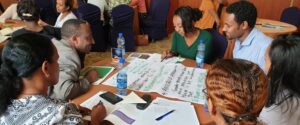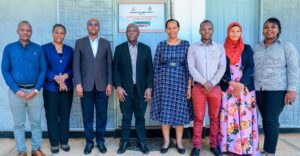Sri Lanka’s scholarship reaches wider audience with communications support
INASP’s Emily Marlow recently spent a week in Sri Lanka working with the country’s National Science Foundation to improve its communications strategy for Sri Lanka Journals Online (SLJOL), the INASP-established platform for Sri Lankan research. She reflects on her trip’s goals and successes.
As a communications specialist, the objective of my visit to Sri Lanka was to work with the National Science Foundation (NSF) to look at key ways to publicise SLJOL both within Sri Lanka and internationally, and to support the development of a strategic communications plan with a focus on the platform.
Since its beginning in 2008, SLJOL has grown substantially and now has 60 journals and up to 18,000 views per month. The site was originally managed by INASP but a phased handover to NSF began in 2013 and is due to be completed by the end of 2015. As part of this handover, SLJOL is now managed by the NSF.
Sri Lankan research is as varied as it is engaging, but despite this intellectual breadth, Sri Lankan academics often face greater challenges communicating these findings than their Northern counterparts. Research is sometimes overlooked and under-cited within academia, due in part to an ingrained (and outdated) status quo bias towards the Northern channels of scholarly communication. SLJOL addresses this bias and provides access to Sri Lankan published research, thereby increasing worldwide knowledge of indigenous scholarship.
Recently, the SLJOL web host has changed from the Public Knowledge Project (PKP) to Ubiquity Press. This change of host has also meant that the site has been upgraded. SLJOL now monitors the number of times that an article or publication is viewed or downloaded, which is a crucial new function giving recognition to academics and their research papers. The recent upgrade makes means it is an ideal time to evaluate how best to promote SLJOL and to look at communication possibilities.
Part of the strategy to promote SLJOL involved working with editors of the site’s existing journals. Dr B.J.C. Perera, Editor of the Sri Lanka Journal of Child Health, is particularly keen on SLJOL promotion. As one of the platform’s founding members, he noted: “The audience for our publication Sri Lanka Journal of Child Health has gone up exponentially – even within a year, the viewing figures went through the roof, many of them from abroad. This is such an important platform, an opportunity to shine a light on academic research and expertise from Sri Lanka. SLJOL can really help to put us ‘centre stage’ on the global academic arena.”
My communications support to NSF included one-to-one sessions with Amila Tennakoon (SLJOL) to look at key audiences and new dissemination routes for SLJOL; working with Amila on key materials and mechanisms to promote SLJOL; holding external meetings with Amila and interested third parties – such as the British Council and the United Nations office in Colombo – to forge new networks for dissemination. I also worked in close collaboration with Amila to develop documents for use in planning and actions related to the promotion of SLJOL, including an SLJOL Promotion Check List with Outline Activities, and an SLJOL Planning Schedule.
Key meetings with NSF staff also explored ways to integrate SLJOL promotion into existing organization activities, and also to advise on any other areas of communication with which NSF needed support. A two-hour general communications session was held with staff in the National Science Library and Resource Centre (NSLRC), and another half-day was spent working directly with key staff to advise on ways to improve their website, written materials and dissemination routes, and to introduce uniformity in the design of all communication outputs.
We reviewed the promotion possibilities for SLJOL to encourage new journals to join up and also to encourage more viewers to the site, looking at ‘piggy backing’ on existing opportunities and the development of new partnerships. We worked on the development of new tools and mechanisms to promote the work of SLJOL, such as letters of invitation to new journals, and leaflets for dissemination at events attended by existing journal editors. We also planned ahead and drew up a schedule with some key objectives and actions. Some of the key challenges we examined included problems of staff time capacity, and also the difficulty of government-funded institutions in forward planning and budget allocation.
A good deal of work took place during my visit. Concentrated into four days, the process was quite intense and I really hope I didn’t exhaust staff too much! Amila and her colleagues at the NSF were keen and exceedingly willing to look at new ways of working on communications output, and seemed to really appreciate our discussion of promotional tools and strategies. Many communication abilities were already evident; it was really a case of teasing out, pulling together and adding to some existing ideas and developing capacity. I look forward to keeping in touch with the NSF’s SLJOL team, and hearing how the promotion of SLJOL progresses.




